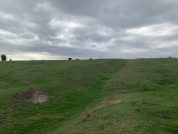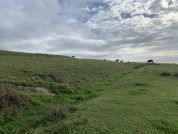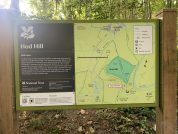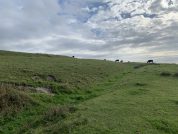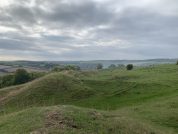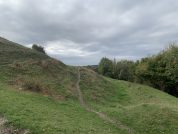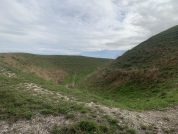Hod Hill (Dunum) Roman Fort
Claudian Auxiliary Fort (AD 43–54)
After this very unequal battle, Vespasian decided to keep a close watch on the recently-surrendered inhabitants by building an auxiliary camp into the north-west corner of the hillfort itself. The fort measures approximately 570 ft north-south by 500 ft east-west (c.174 x 152 m), giving an occupation area of around 6½ acres (c.2.6 ha). It is very likely that the surviving round-houses remained in use by the natives for some time, possibly providing services for the Roman troops in the form of locally grown foodstuffs, livestock, baked-goods, locally-brewed beer, and of course, women.
The lack of any identifiable Roman road in the immediate area, plus the fact that Hod Hill is not mentioned in any of the later classical geographies, leads one to conclude that Roman occupation of the hillfort was not to last long, and following the withdrawal of the garrison the settlement was soon abandoned. In fact, the main reason that the auxiliary troops were withdrawn may have been that the native population in the area had dwindled to such a small number that they no-longer represented a threat, or perhaps they had been seduced by the prosperity which followed in the wake of the Roman invaders, either way, a local Roman garrison was seemingly not needed (see Webster).
Observation and Excavation at Hod Hill
During excavations over the years in the Roman occupation levels at Hod Hill a number of animal bones have been uncovered, including those of Ox, Sheep, Pig, Red Deer and Hare; the latter animal very likely being hunted and killed for sport and as a means of pest control. In addition, the shells of Oyster and Edible Snail also the bones of several types of birds, including Chicken, Mallard, Woodcock, Woodpigeon, Coot, and other wildfowl (see Davies).
In south Britain the fort at Hod Hill [1 O.G.S. Crawford and A Keiller, Wessex from the Air, 1928, 36-41, pl. i; JRS XL, 1950, pl. viii, 1; XLII, 1952, 99; below p. 124.] (ST 855108) [2 The references are to the National Grid.] is the only example of a Roman military earthwork of the period of the invasion that survives in good order. Its position, within the highest corner of a native fortress, offers an exceptional chance of defining the relation between Roman and native works. The contribution of air reconnaissance to this problem is two-fold. Available photographs display the defences of the native fortress, its ditches, ramparts and spoil-pits, and show a sample of the structures that occur within it. In a sector of the native fort, ploughed in 1949, the marks of hut-circles, working-floors, pits and hollows are clearly seen, so that the detailed economy of an oppidum lies in large part revealed. Striking views have also been obtained of the defences of the Roman fort, while in the interior the main streets and the outlines of building-plots, some terraced on the hill-slope, were seen as soil marks after fresh ploughing. In the western half of the fort are a number of regularly arranged oblong plots, but the general plan does not conform to later standards. The most prominent of native remains beneath the Roman levels occurs at the very summit of the whole hill, where, crossed by the via praetoria of the Roman fort, a well-marked ring-ditch is visible. Only digging can show whether this is a chance coincidence of a native hut with the summit, or whether it is the ring-ditch of a barrow erected thereon, perhaps long before even the native hill-fort was constructed.” (JRS 1953 p.82)
References for Dvnvm
- Iron Age Communities in Britain by Barry Cunliffe (London, 1974);
- The Roman Military Diet by R.W. Davies, in Britannia ii (1971) pp.122-142;
- Air Reconnaissance of Southern Britain by J.K. St. Joseph in J.R.S. XLIII (1953) pp.81-97;
Map References for Dvnvm
NGRef: ST8510 OSMap: LR194
Roman Roads near Dvnvm
None identified
Sites near Hod Hill (Dunum) Roman Fort
- Hod Hill (Hillfort) (0 km)
Iron Age Hillfort - Hambledon Hill (2 km)
Iron Age Hillfort and Neolithic Causewayed Enclosure - Iwerne Villa (3 km)
Villa - Farnham Villa (11 km)
Pottery and Villa - Vindocladia (Shapwick) (13 km)
Minor Settlement - Shapwick (Vindocladia Burgus) Roman Fort (13 km)
Claudian Auxiliary Fort (AD 43–54) - Badbury Rings (13 km)
Iron Age Hillfort - Dewlish Villa (16 km)
Villa - Ackling Dyke (17 km)
Roman Road - Lake Farm Roman Vexillation Fort (18 km)
Vexillation Fort
